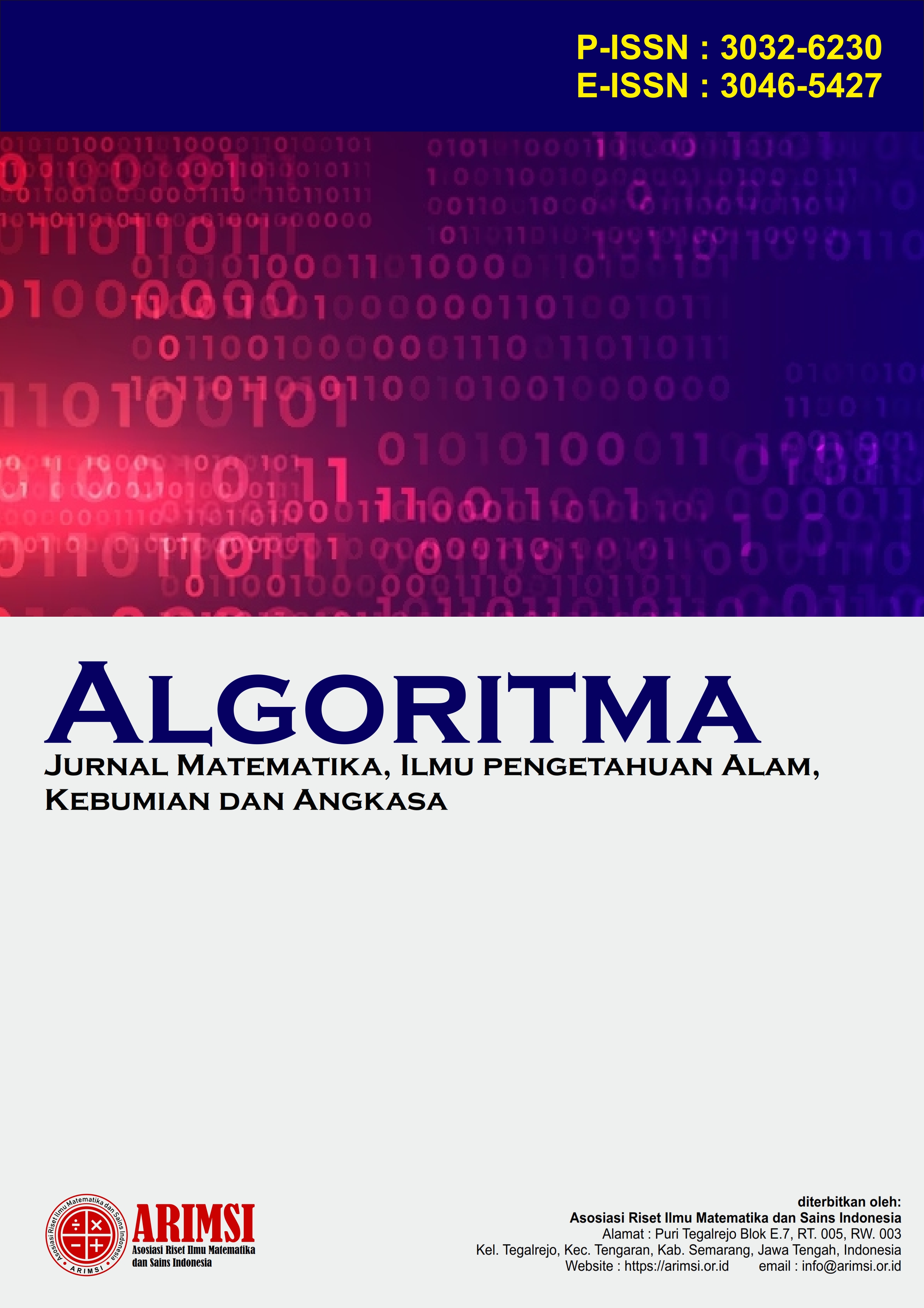Analisis Keterampilan Berpikir Kreatif Siswa SMA Negeri 4 Gorontalo Dalam Menyelesaikan Soal Hots Pada Materi Laju Reaksi
DOI:
https://doi.org/10.62383/algoritma.v2i3.61Keywords:
creative thinking skills, reaction rateAbstract
This research aims to determine the achievement of aspects of students' creative thinking skills and the data collection technique for this research uses an essay test with 4 questions, this research is qualitative research, the sample in this research is 100 students of class XI-IPA. The results of the research show that students' creative thinking skills as a whole fall into the quite creative category with an average total percentage of 60%. With the level of students' creative thinking skills in solving High Order Thinking Skills (HOTS) questions on the reaction rate material in the fluency aspect of 58% in the quite creative category, in the flexibility aspect it was 53% in the quite creative category, in the originality aspect it was 70% in the quite good category, and the level of students' creative thinking skills in the elaboration aspect was 59% in the quite creative category.
Downloads
References
Aryani, I., & Maulida. (2019). Analisis kesalahan siswa dalam menyelesaikan soal matematika melalui higher order thinking skills (hots). Jurnal Serambi Ilmu, 20(2), 274–290. https://www.ojs.serambimekkah.ac.id/serambi-ilmu/article/view/1459
Beghetto, R. A., & Kaufman, J. C. (2007). Toward a broader conception of creativity: A case for "mini-c" creativity. Psychology of Aesthetics, Creativity, and the Arts, 1(2), 73–79
Hidayat, T., Susilaningsih, E., & Kurniawan, C. (2018). The effectiveness of enrichment test instruments design to measure students’ creative thinking skills and problem-solving. Thinking Skills and Creativity, 29(February), 161–169. https://doi.org/10.1016/j.tsc.2018.02.011
Idrus, W.H.A., Saprizal, H. & Eka, J. (2020). Pendekatan Green Chemistry Dalam Modul Praktikum Kimia Lingkungan Untuk Meningkatkan Kreativitas Mahasiswa Calon Guru Kimia. Chemistry Education Practice. 3 (2). 70-73.
Jufri, M. D., Maming, R., & Rusli, M. A. (2020). Studi Keterampilan Berpikir Tingkat Tinggi Peserta Didik Kelas Ix Smpn Di Kota Makassar. Jurnal IPA Terpadu, 4(1), 23–35. https://doi.org/10.35580/ipaterpadu.v4i1.11323
Juwita, E. S., & Aninditya, D. S. (2020). Analisis Kemampuan Berpikir Kreatif Peserta Didik Pada Pembelajaran Kimia di Kelas X MIA SMA Negeri 6 Padangsidimpuan.Jurnal Education and Development.8(2), 470–473.
Kim, K. H. (2011). The creativity crisis: The decrease in creative thinking scores on the Torrance Tests of Creative Thinking. Creativity Research Journal, 23(4), 285–295.
la Moma dkk. (2015). Pengambangan Instrumen Kemampuan Berpikir Kreatif Matematis Untuk Siswa SMP. 2017, 4(April), 27–41.
Marwani, R., & Sani, A. R. (2020). Pengaruh Model Project Based Learning Berbasis STEM Terhadap Kemampuan Berpikir Kreatif Siswa Pada Materi Pokok Fluida Statis di Kelas XI SMA Negeri 4 Tebing. Jurnal Inovasi Pembelajaran Fisika , 8(2), 8–15.
Mahanal, S., & Zubaidah, S. (2015). Potensi Model Pembelajaran RICOSRE dalam Meningkatkan High Order Thinking Siswa. MSOpen FMIPA UM, 2(5), 141–157.
Meika, I., & Sujana, A. (2017). Kemampuan Berpikir Kreatif Dan Pemecahan Masalah Matematis Siswa Sma. Jurnal Penelitian Dan Pembelajaran Matematika, 10(2), 8–13. https://doi.org/10.30870/jppm.v10i2.2025.
Munandar, Utami. (2017). Mengembangkan Bakat dan Kreatiivitas Anak Sekolah. Jakarta: PT. Gramedia.
Nurfauziah, P., Maya, R., & Rahman, H. (2023). Analisis Kemampuan Berpikir Kreatif Siswa Smk Kelas. Jurnal Pembelajaran Matematika Inovatif, 6(2), 473–482
Runco, M. A. (2014). Creativity: Theories and themes: Research, development, and practice. Academic Press.
Rosa, N.M., & Nursa'adah, F.P. (2017). Kontribusi Laboratorium Kimia Dan Sikap Siswa Terhadap Pemanfaatan Laboratorium Terhadap Keterampilan Berfikir Kritis dan Kreatif. Jurnal Formatif,7 (3). 198-206.
Smith A., & Jones, B. (2018). Exploring Creativity in High School Chemistry: A Case Study on Reaction Rates. Journal of Chemical Education, 95(6), 1003–1009.
Sani, R. A. (2019). Pembelajaran Berbasis HOTS (High Order Thingking Skills). Jakarta: Tira Smart.
Satriawan, M., Rosmiati, R., Widia, W., Sarnita, F., Suswati, L., Subhan, M., & Fatimah, F. (2020). Physics learning based contextual problems to enhance students’ creative thinking skills in fluid topic. Journal of Physics: Conference Series, 1521(2). https://doi.org/10.1088/1742-6596/1521/2/022036
Saraswati, P. M. S., & Agustika, G. N. S. (2020). Kemampuan Berpikir Tingkat Tinggi Dalam Menyelesaikan Soal HOTS Mata Pelajaran Matematika. Jurnal Ilmiah Sekolah Dasar, 4(2), 257. https://doi.org/10.23887/jisd.v4i2.25336
Suryani, M., Jufri, L. H., & Putri, T. A. (2020). Analisis Kemampuan Pemecahan Masalah Siswa Berdasarkan Kemampuan Awal Matematika. Mosharafa: Jurnal Pendidikan Matematika, 9(1), 119–130. https://doi.org/10.31980/mosharafa.v9i1.605
Tawil dan Liliasari.,(2013). Kemampuan berpikir kreatif siswa SMA yang diajar dengan model team accelerated instruction pada pokok bahasan sistem periodik unsur. Bivalen: Chemical Studies Journal, 2(1), 01–04. https://doi.org/10.30872/bcsj.v2i1.292
Downloads
Published
How to Cite
Issue
Section
License
Copyright (c) 2024 Algoritma : Jurnal Matematika, Ilmu pengetahuan Alam, Kebumian dan Angkasa

This work is licensed under a Creative Commons Attribution-ShareAlike 4.0 International License.





